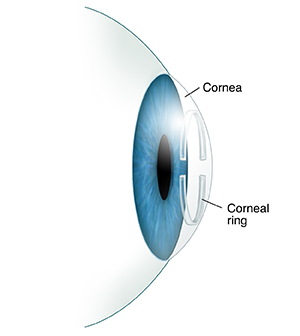A
B
C
D
E
F
G
H
I
J
K
L
M
N
O
P
Q
R
S
T
U
V
W
X
Y
Z
Topic IndexLibrary Index
Click a letter to see a list of conditions beginning with that letter.
Click 'Topic Index' to return to the index for the current topic.
Click 'Library Index' to return to the listing of all topics.
Understanding corneal ring implantation
Corneal ring implantation is a type of eye surgery. It inserts a small, plastic ring into the middle layer of the cornea. This is done to correct certain eyesight problems, so you can see more clearly. This procedure is also known as corneal implant surgery. It can involve several types of implants or devices. These are made to fix certain eye problems.
About the cornea
The cornea is the eye’s outermost layer. It is a clear, strong layer on the front of your eye. It helps protect your eye from dirt, germs, and other things that may cause damage. It also helps control how light enters your eye.
Some conditions may occur that can change the cornea’s shape. If the cornea has an abnormal shape, light rays don’t focus where they should. If this happens, you may have poor eyesight even when wearing glasses. A corneal ring implant helps flatten and reshape your cornea. It helps the light rays focus at the right place and improves your eyesight. Some people may not need to wear eyeglasses after a corneal ring implantation. Others may still need to wear glasses but have better eyesight.
Why corneal ring implantation is done
You may need corneal ring implantation to treat poor eyesight caused by eye problems such as:
-
Keratoconus. This condition causes the cornea to become cone-shaped over time. Experts don't know why this happens.
-
Pellucid marginal degeneration. This condition is when the cornea becomes too thin.
-
Swelling of the cornea after eye surgery. LASIK surgery is a kind of surgery to fix vision problems. After surgery, the cornea may swell. This can cause new eyesight problems. If swelling happens, your healthcare provider may advise corneal ring implantation to fix the vision changes.
How corneal ring implantation is done
Your procedure will be done by an eye surgeon. The surgery can be done in several ways. The surgeon will make small cuts in the outer edge of your cornea. They will make tunnels under the outer layer of your cornea. Sections of the ring are put into these tunnels. The cuts on the cornea are then closed with very small stitches (sutures).

Risks of corneal ring implantation
All procedures have risks. Some of the risks of corneal ring implantation are:
-
Swelling of the cornea
-
Small hole (perforation) in the eye
-
The ring poking out from the cornea (extrusion)
-
Eye swelling
-
Movement of the ring
-
Halos (rings) around lights at night
-
Seeing light as too bright (glare)
-
Ongoing eye pain
-
Infection
-
Not much eyesight correction
-
Causing another eyesight problem, such as astigmatism
-
Need for an adjustment surgery
Your risks may differ based on your age, your health, and the condition of your cornea. Talk with your healthcare provider about which risks apply most to you.
Online Medical Reviewer:
Heather M Trevino BSN RNC
Online Medical Reviewer:
Rajadurai Samnishanth
Online Medical Reviewer:
Whitney Seltman MD
Date Last Reviewed:
8/1/2024
© 2000-2024 The StayWell Company, LLC. All rights reserved. This information is not intended as a substitute for professional medical care. Always follow your healthcare professional's instructions.